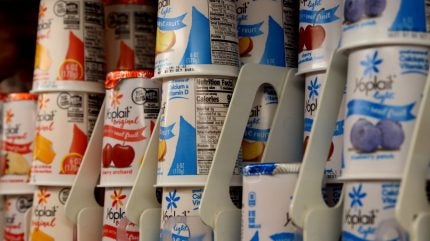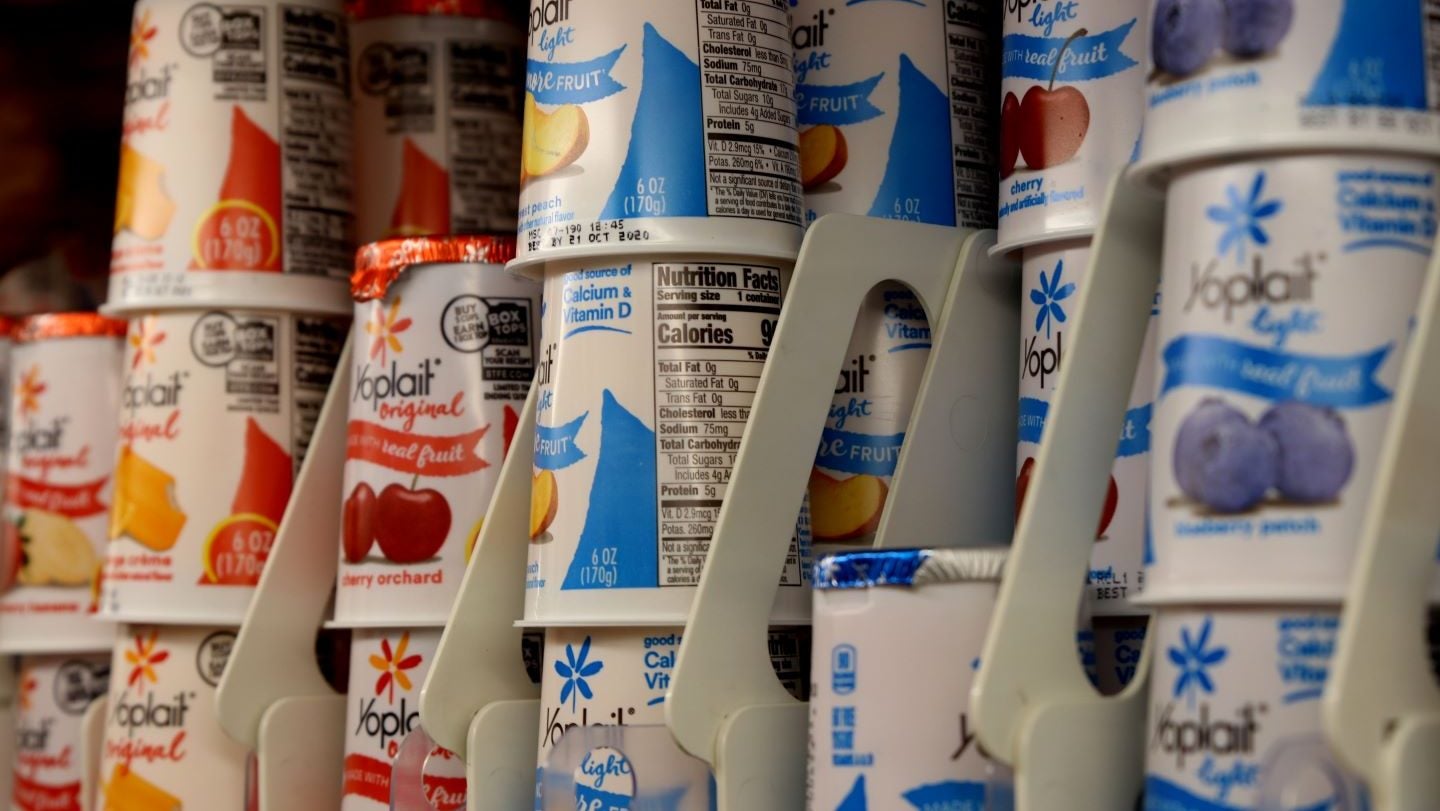
Alongside our daily news coverage, features and interviews, the Just Food team sifts through data sets to bring you a round-up of the week in numbers.
General Mills made the M&A headlines a couple of times in recent days, with one confirmed deal and one potential disposal said to be under consideration.
Meanwhile, a number of the publicly-listed FMCG majors to report Q1 results this week have highlighted the lingering signs of weak spending among pockets of US consumers.
And Oatly CEO Jean-Christophe Flatin claimed the alt-dairy business is making progress as the company reported narrowing first-quarter losses.
Might General Mills sell again in yogurt?
Three years ago, General Mills sold its controlling interest in its European yogurt operations to co-shareholder Sodiaal, a French dairy co-operative.
The Cheerios and Nature Valley brands owner is now reportedly looking into the potential sale of its yogurt business in North America.
Access the most comprehensive Company Profiles
on the market, powered by GlobalData. Save hours of research. Gain competitive edge.

Company Profile – free
sample
Your download email will arrive shortly
We are confident about the
unique
quality of our Company Profiles. However, we want you to make the most
beneficial
decision for your business, so we offer a free sample that you can download by
submitting the below form
By GlobalData
According to Reuters, the US group has appointed investment banking group JPMorgan Chase to help it find new buyers for the assets.
As part of the 2021 deal, General Mills fully acquired Yoplait in Canada. It was also granted a reduced royalty rate to use the Yoplait and Liberté brands across North America.
There’s been no official word yet from General Mills on whether it has any plans to offload its yogurt business in North America.
However, the US yogurt market is hardly forecast to see stellar growth as we move through the decade, so, perhaps it would not be a surprise if the business is weighing up its options.
General Mills, meanwhile, this week added to its assets in pet food with a move in Europe. The Blue Buffalo owner snapped up Edgard & Cooper, a group, the US company said, that booked around €100m ($107m) in retail sales for 2023.
Announcing the deal, General Mills said the transaction was part of its “accelerate” strategy, a programme announced in 2021 to try to improve the company’s annual sales growth.
Volume growth remains hard to come by at Kraft Heinz
Sales volumes in Kraft Heinz remained in negative territory in the first quarter of the year as cash-strapped consumers looked for cheaper options.
When the condiments group published its 2023 numbers in February, the company said it was anticipating a return to “historical activity” volume levels in the latter half of 2024 after posting another volume decline in its fourth quarter.
At the time, CEO Carlos Abrams-Rivera said the ketchup and soup giant was “already seeing” a bounce-back after disappointing “volume/mix” results in the business’ 2023.
However, fast-forward to this week and the company’s Q1 results and it was clear how much of a challenge Kraft Heinz faces in getting its volumes back in growth.
Volumes fell by 3.2 percentage points in the three months ended 30 March, though this was an improvement on the 4.4 percentage point decline seen in the fourth quarter of 2023.
Speaking to analysts on Wednesday (1 May), Abrams-Rivera said Kraft Heinz still believes its volumes will get back to historical levels later in 2024 but added: “Like many companies we continue to navigate through short-term volatility – [a] pressured consumer, persistent inflation, headwinds from SNAP [Supplemental Nutrition Assistance Programme], industry softness in away from home and rising supply chain risks are some of the common themes the industry is currently facing.”
The US foodservice channel has proved a particular challenge to Kraft Heinz as cost-conscious consumers are eating out less with Abrams-Rivera admitting “these results were impacted by softening markets in the US, especially for restaurants”.
But he added: “Despite the challenges we’re seeing in the restaurant industry, we continue to outpace the industry and capture share in US away from home.”
Meanwhile, at Mondelez, volume/mix melts away
The Cadbury and Milka maker had spent much of 2023 pushing up prices and seeing little effect on demand.
Sure, negotiations with retailers, particularly in Europe, could prove tough but, in the main, consumers didn’t appear to be put off by Mondelez’s moves to raise prices.
The company still managed to grow its “volume/mix” in 2023. The household name nature of some of Mondelez’s key brands and the relative insulation categories like chocolate enjoy from private label (the growth in volume/mix for Mondelez’s chocolate business in 2023 was almost double that for the whole company), benefited the company. When Mondelez announced its 2023 numbers in January, it told investors elasticities still remained “at or below historical norms”.
The group’s Q1 numbers looked less rosy. Its volume/mix in the opening quarter of 2024 fell 2.1%, with CFO Luca Zaramella pointing to a 3.6% decline in Mondelez’s developed markets, which he said was due to “customer disruption in Europe” and “softness” in the US biscuit market.
CEO Dirk Van de Put said: “Our core categories of chocolate, biscuit, and baked snacks are still demonstrating relatively more resilience and lower elasticity than the broader food universe.”
But he added that in North America, “lower-income consumers feel pressured and we see that pressure weighing on their frequency in the category, especially among brands that skew more to that group.”
A little optimism at Oatly
In a similar fashion to its publicly-listed peer Beyond Meat, alt-dairy business Oatly has found the going tough since its IPO.
When Oatly listed on the Nasdaq in 2021, its shares started trading at over $22. At the time of writing, they stand at around $1.21. Investor appetite for alt-protein businesses has taken a bit of a knock as demand hasn’t perhaps hit the heights some expected a few years ago.
There have been, in the last 18 months or so, some notes of concern through the non-dairy drinks category about the growth trajectory for the whole market.
The impact of Covid-19 lockdowns in Asia, particularly in China, didn’t help Oatly but the company has had issues in its supply chain, which have weighed on its margins, profitability and therefore its share price.
In November, Oatly said it would desist from the building of new production facilities for its EMEA and Americas segments. CEO Jean-Christophe Flatin said at the time the company had chosen to focus on an “asset-light strategy”, following “a detailed review of our supply chain networks in both regions”. The Sweden-based business made a loss of more than $400m in 2023 despite rising revenues.
On Tuesday (30 April), Flatin published Oatly’s first-quarter results and claimed the alt-dairy business is making progress as the company reported narrowing first-quarter losses.
First-quarter revenue inched up 1.8% to $199.2m and by 1.2% at a constant-currency rate. Volume was up 3.1%. Oatly cited “solid growth” from its North America business and its Europe & International division.
The company stuck to its financial forecasts for 2024. Oatly estimates its annual revenue will rise 5-10% when measured on a constant-currency basis. It is also forecasting an adjusted EBITDA loss of $35-60m. In 2023, Oatly booked an adjusted EBITDA loss of $157.6m.
The former Mars executive, named CEO last year, pointed to the improvement in Oatly’s gross margins.
“We are clearly seeing the benefits from the bold actions we have taken over the past two years. These benefits are most clear in our gross margin expanding nearly 1,000 basis points year-over-year, as well as our reduced SG&A, which was partially aided by certain fees and selling expenses that will hit a bit later than we planned,” he said.
Nevertheless, Flatin explained why Oatly had retained its outlook for 2024. “While we are encouraged by our first-quarter results, we recognise that we are only one quarter through the year and that our three operating segments are in very different stages of their turnaround journeys, their maturity, their execution and the amount of traction they have achieved on the strategic actions,” he said.
“Decades of business experience tells us that one quarter does not make the year. We are satisfied with our first quarter but we recognise we have three quarters in front of us to deliver to make a year.”


